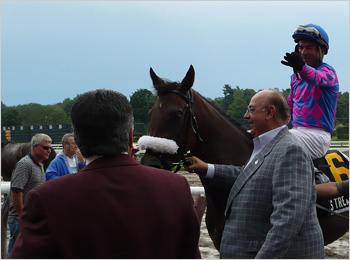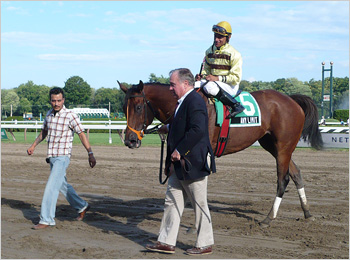Today’s Longshot Flyer
SAR, R4: Special Detail (ML 12-1). Starts off a dismal debut in which the Johar filly was beaten by more than 33 lengths, but I’m intrigued by the distance and surface switch.
Results: Bet down to 6-1, which totally killed my interest in this filly, and good thing, since she tracked the pace early, then dropped like a rock to last in the stretch. The winner was 2-1 favorite High Cry, a Street Cry filly debuting for trainer Todd Pletcher, now 4-for-12 with 2-year-old first-time starters at the Spa (and all four of those wins with rider John Velazquez up). I did get to feel smart in the second at least, sticking with Digger off his odd claim last out in a race with conditions (“For three year olds and upward which have started for a claiming price of $25,000 or less in 2006-08”) that seemed beautifully suited. He went to post as the fourth choice, willingly waited for the dueling leaders to tire, and paid $9.20 to win by two lengths.
Thanks to 6-1 Raffie’s Treasure in the feature, trainer Dominic Galluscio avoided “getting the duck” this meet, scoring his first win after four seconds and two thirds over the past couple weeks. If I Lost My Choo hadn’t scratched, it’s possible Galluscio would have added another second to his record, but with the overwhelming likely favorite out, the homebred filly was free to race clear on the outside, avoiding the flying mud, then draw away to a visually impressive 9 3/4 length win over the sloppy track (final time for the 1 1/8 miles, 1:53.48). “We were very fortunate that [the race] came off the turf,” said Galluscio (Daily Gazette).

Raffie’s Treasure entering the winner’s circle after the ninth.
Today’s Longshot Flyer
SAR, R8: Halo Najib (ML 10-1). The one-mile turf Majestic Light comes up tough with Prussian (second to Virginia Derby winner Gio Ponti in the Hill Prince) and Luck Money (good enough as a 2-year-old to run third to Henrythenavigator in G2 company) entered, but Halo Najib gets some class relief regardless and maybe even some pace at which to run.
Results: Halo Najib showed zip and was an underlay at 8-1, finishing seventh, many lengths behind Luck Money and Prussian. Since this was a flyer, I was unperturbed at the loss, which was more than made up for by 6-1 Any Limit (with Zada Belle underneath) in the Honorable Miss (true, I told this person while in the paddock). “Wire to wire, that was nice,” said trainer Allen Jerkens, who did not go to the winner’s circle. The mare will point to the Ballerina.

Any Limit returning to the winner’s circle after the ninth.
Today’s Longshot Flyer
BEL, R8: So It Goes (ML 20-1). Lightly raced, gets blinkers, class test in the French Colonial, a delightfully competitive Thursday afternoon stakes with a ho-hum 3-1 morning line favorite in El Sultry Sun, coming off a seventh-place finish in the rain-soaked G3 Colonial Turf Cup. Also of much interest as a live longshot is Dynhocracy (ML 10-1), who had a troubled trip and finished fifth in the June G3 Hill Prince, his first start in nearly four months. Willsboro Point (ML 6-1), a smart claim for trainer Scott Schwartz three back, looks the most likely pacesetter, and I wouldn’t put it past him, with Eibar Coa up, to steal the race with soft fractions.
[Results: So It Goes, sent off as the longest shot in the field at 14-1, finished fourth. No early speed, that one, despite the first-time blinkers. Fourth choice Willsboro Point won by 1 1/2 lengths at 5-1 and did so by rating kindly, settling in behind an eager Run Sully Run and waiting through fractions of :48.88 and 1:12.87 before drawing away and running the final eighth in a stellar :11.78. The Point Given gelding (out of G3-winning mare Petrouchka) claimed for $35,000 by Schwartz on May 24 now boasts a record of 8-4-0-2.]
Copyright © 2000-2023 by Jessica Chapel. All rights reserved.